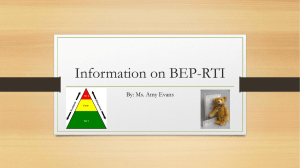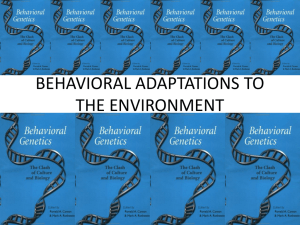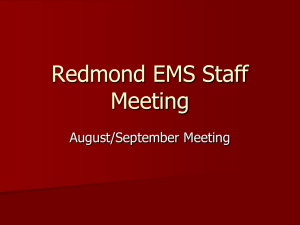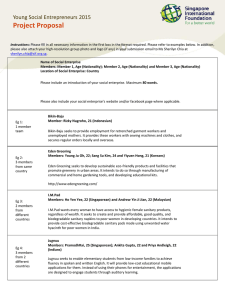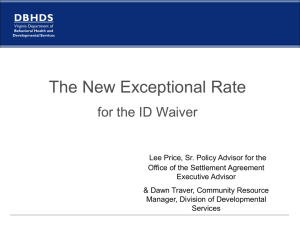Improved Management and Communication Using the DISC Model
advertisement
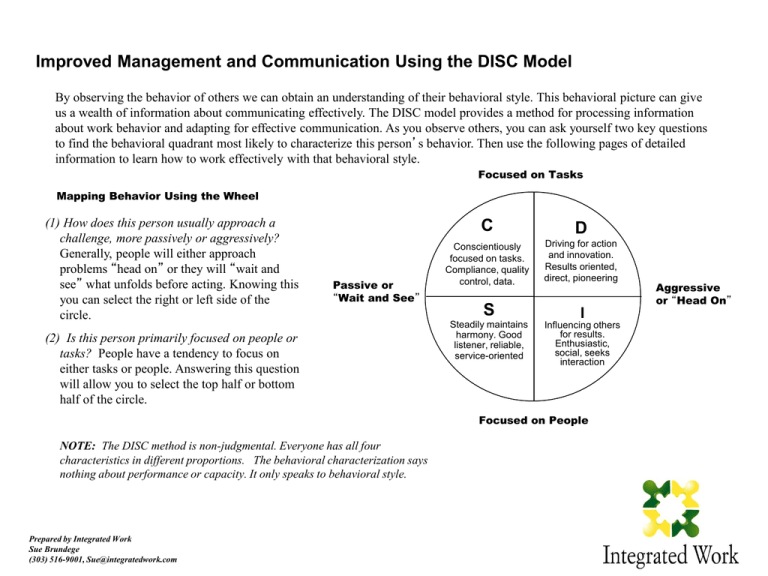
Improved Management and Communication Using the DISC Model By observing the behavior of others we can obtain an understanding of their behavioral style. This behavioral picture can give us a wealth of information about communicating effectively. The DISC model provides a method for processing information about work behavior and adapting for effective communication. As you observe others, you can ask yourself two key questions to find the behavioral quadrant most likely to characterize this person’s behavior. Then use the following pages of detailed information to learn how to work effectively with that behavioral style. Focused on Tasks Mapping Behavior Using the Wheel (1) How does this person usually approach a challenge, more passively or aggressively? Generally, people will either approach problems “head on” or they will “wait and see” what unfolds before acting. Knowing this you can select the right or left side of the circle. Passive or “Wait and See” (2) Is this person primarily focused on people or tasks? People have a tendency to focus on either tasks or people. Answering this question will allow you to select the top half or bottom half of the circle. C D Conscientiously focused on tasks. Compliance, quality control, data. Driving for action and innovation. Results oriented, direct, pioneering S Steadily maintains harmony. Good listener, reliable, service-oriented I Influencing others for results. Enthusiastic, social, seeks interaction Focused on People NOTE: The DISC method is non-judgmental. Everyone has all four characteristics in different proportions. The behavioral characterization says nothing about performance or capacity. It only speaks to behavioral style. Prepared by Integrated Work Sue Brundege (303) 516-9001, Sue@integratedwork.com Aggressive or “Head On” Aggressively Task Focused - The High “D” - Dominant Style Recognizing a High D Behavioral Style Behavior You May Notice: Applying Knowledge of the High D Behavioral Style Working with the High D: • Allow freedom from control, supervision and details - don’t micromanage, or dwell on details unless they express interest. • Expect impatience with the process. They may look for shortcuts or break the rules to accomplish results most efficiently. They may imply “The end justifies the means.” May have short fuse • Don’t take conflict with the High D personally. • Task oriented, seeks results • Provide challenge and opportunity, allow them to pioneer new methods and ideas. • Direct in communicating • Present facts logically, use facts to support an argument or specific examples. • Fights back in response to conflict • Evaluate on results, not process: the”what”, not the “how.” • May interrupt or do other things while others are talking • Clearly explain what results are expected. • Aggressively solves problems or meets challenges • Has need for control • Demanding of self and others • Adapting Your Communication for Effectiveness: • Pioneering, sees change as indicator of progress • Strong handshake, direct eye contact, controlled gestures, lean toward them. • Relieves stress through physical activity • Strong, confident and direct tone of voice, don’t waste time or “chit-chat.” • Use words like: “Win”, “Lead the pack”, “Challenge”, “New”, and “Results.” Signs you need to adapt your communication style: • Looks at watch • Encourage them to express their ideas and opinions, and listen carefully. • Leans back in chair • Limit expression of emotion or discussion of feelings. • Attacks • Allow them to make decisions - give options rather than ready-made decisions. • Begins to focus on another activity • If you disagree with their argument, be straightforward and say why you differ. Developmental Areas • Interpersonal communication: listening skills, tact and diplomacy • Patience in working with others and letting things unfold; openness to others’ methods, ideas • Team building: help them see the value of working with a team, appreciation for a diversity of skills Prepared by Integrated Work Learning More: Consider the person you are working with: How intense are they? Characteristics may be more pronounced in an intense person and more subtle in someone who is less intense. Do they also lean towards persuading people or facts and procedures? Read sections on “C” or “I” for more information. More focus on facts and procedures D C S I More focus on persuading people Persuading and Promoting - The High “I” - Influencer Style Recognizing a High I Behavioral Style Behavior You May Notice: Applying Knowledge of the High I Behavioral Style Working with the High I: • Provide opportunities to use verbal skills and express ideas and opinions • Allow them to work and interact with others, assign tasks that maximize their innate people skills, encourage them to use their people skills to resolve conflict Uses a lot of gestures when communicating • Expect some disorganization or lack of attention to time schedules. Will use influence and relationships with others to motivate and inspire them or accomplish goals • Be clear about deadlines and timeframes that are critical. • Set clear objectives of tasks to be accomplished, however allow freedom from tight controls - don’t micromanage • Evaluate on results, not process: the “what”, not the “how.” • Provide positive feedback by recognizing them for their abilities and accomplishments • May by sidetracked by people issues, but they are good at solving people problems. • May not notice change, doesn’t mind it. • Extraverted, sociable, talkative • Focus on relationships and interaction with others • • • May dominate the conversation, very verbal • Enthusiastic and team oriented • Will be warm and expressive • Seeks fun experiences • Relieves stress through social interaction and discussion Adapting Your Communication for Effectiveness: Signs you need to adapt your communication style: • Relaxed communication with friendly eye contact. • Looks around, no eye contact • Enthusiastic, friendly and energized tone of voice. Use humor and expressive gestures. • Silence • Use words like: “Fun”, “Teamwork”, “I feel”, “Exciting”, “Makes you look good” • Skepticism, negativity • Focus the conversation on the impact on people. • Don’t move straight to business, warm up to the discussion with social conversation. Developmental Areas Developmental Areas: • Time or project management • Setting goals, planning, following through • Listening skills Prepared by Integrated Work Learning More: Consider the person you are working with: How intense are they? Characteristics may be more pronounced in an intense person and more subtle in someone who is less intense. Do they also tend to be driving, or blunt or are they concerned about how others feel? Read sections on “D” or “S” for more information. C S More driving, blunt I More concerned about how others feel Stable and Supportive - The High “S” - Steadiness Style Recognizing a High S Behavioral Style Applying Knowledge of the High S Behavioral Style Behavior You May Notice: Working with the High S: • Generally quiet, but very good listeners • Prepare them for changes, allow opportunity to finish tasks and receive closure. • People oriented, seeks harmony and steadiness • • Will usually listen first when communicating with others Capitalize on their excellent listening skills, desire for harmony, and eagerness to serve by assigning tasks that require those attributes. • Provide a non-threatening work environment. • Works at a steady pace, reliable and focused • Assign fewer, larger projects, with a long-term focus. • May use “To Do” lists • Encourage their participation in meetings, draw out their thinking. • May display little or no emotion in general conversation • Involve them in long-term planning, tap their need to serve and their organizational abilities. • Seeks to serve others, to help • Clearly define parameters, requirements of tasks. • Does not back down easily when “right” • • Relieves stress through sleep or relaxation Understand that their goals will be shorter term, low-risk. Over time you can develop mutual trust and work with them to stretch into new areas. Adapting Your Communication for Effectiveness: Signs you need to adapt your communication style: • Asks you to repeat information • Gently tries to end the meeting Developmental Areas • Assertiveness, willingness to take risks • Long-term planning • Discuss feelings when appropriate rather than internalize • Help starting new assignments Prepared by Integrated Work • Relaxed with friendly eye contact, use warmth and small gestures. • Friendly, soft tone of voice, slow pace, low volume. • Use words like: “Help me out”, “Step by step”, “Steady.” • Make an effort to get to know them. Learning More: Consider the person you are working with: How intense are they? Characteristics may be more pronounced in an intense person and more subtle in someone who is less intense. Do they also lean towards persuading people or on rules and procedures? Read sections on “C” or “I” for more information. C More focus on rules, procedures S D I More focus on people Conscientiously Task Focused - The High “C” - Compliance Style Recognizing a High C Behavioral Style Behavior You May Notice: Applying Knowledge of the High C Behavioral Style Working with the High C: • Task oriented, can seem removed from interpersonal interactions. • Allow plenty of time for the person to think and consider ideas. Do not ask for “on-the-spot” responses. • Concerned about quality, standards, and procedures • Provide a work environment where critical thinking is needed and rewarded. • Seeks data, information • Provide as much data and information as possible. • Prefers work environment with few people, and little noise • Wherever quality is important, include them in planning and implementation. • Prepare them for change, allow plenty of time to complete what has already begun. • Will be direct and to the point when talking to others, uses questions to gather data and clarify information • Provide work space with few distractions, low noise, few people. • Clearly define the requirements of their position and expectations for performance. • Encourage their participation in meetings: they may be reluctant to speak up. • Encourage problem solving, and setting goals that lead them to stretch. • Excellent organizational skills, everything has a place • May be introverted Adapting Your Communication for Effectiveness: • May overanalyze problems: analysis paralysis • Use facts and data to support your point, not opinions or feelings. • May be overly critical of others • Don’t bring poorly thought out plans or limited data to the table. • Relieves stress through alone time • Limit use of gestures, don’t invade their space. • A controlled, thoughtful tone of voice is most effective. • Use words like, “The Facts,” “No risks,” “Procedure,”and “Proven” • Use direct eye contact. Signs you need to adapt your communication style: • Evasiveness • Little or no verbal communication • Tries to end meeting by asking difficult questions Developmental Areas • Negotiation, people skills • Managing conflict rather than avoiding it • Flexibility and adaptability to change Prepared by Integrated Work Learning More: Consider the person you are working with: How intense are they? Characteristics may be more pronounced in an intense person and more subtle in someone who is less intense. Do they also focus on the impact of the plan on people or on strategy? Read sections on “S” or “D” for more information. More focus on strategy C D More focus on impacts of the plan on people S I

